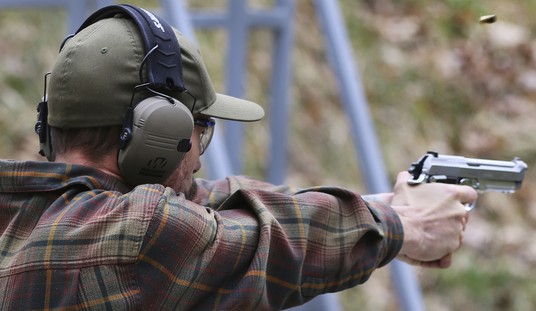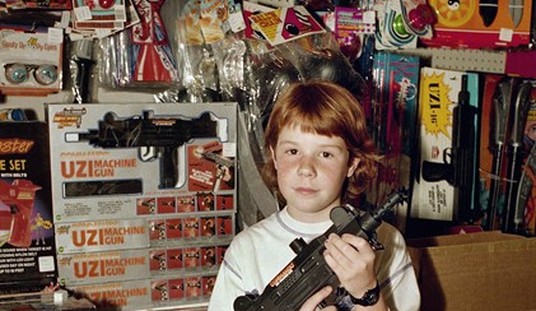
@bob_owens They couldn’t let Rolling Stone and Yahoo Finance hog all the ignorance @TheAtlantic
— TheH2 (@TheH2) July 28, 2014
An article published in The Atlantic today asserts that the Army’s Modular Handgun System (MHS)* will result in “blood on the streets” in the near future because the Army’s adoption of the Beretta M9 9mm pistol lead to the popularization of high-capacity pistols among civilian criminals in the 1980s. Those who actually know a little bit about firearms find that conclusion to be nothing short of deranged.
The writer—an under-educated photography and writing instructor named Matt Valentine at the University of Texas at (where else?) Austin—asserts:
This week, the U.S. Army will brief arms manufacturers on the design requirements for a new standard-issue handgun. Several gun makers will compete for the lucrative contract, developing weapons that are more reliable and more powerful than those currently in service. Officials say the upgrade is overdue—it’s been nearly 30 years since the Army adopted the Beretta M9. But the last time the military challenged the industry to make a better handgun, all the innovations intended for the battlefield also ended up in the consumer market, and the severity of civilian shootings soared.
Studying gunshot injuries in the D.C. area in the 1980s, Daniel Webster of Johns Hopkins University noticed an alarming trend—as time went on, more and more patients were arriving at the emergency room with multiple bullet wounds. In 1983, at the beginning of the study period, only about a quarter of gunshot patients had multiple injuries, but in the last two years of the study, that proportion had risen to 43 percent. Over the same period, semiautomatic pistols with a capacity of 15-rounds (or more) were replacing six-shot revolvers as the most popular firearms in the country. It’s not difficult to see the correlation—more bullets in the guns, more bullets in the victims. But why had guns changed so radically in such a short period of time?
In 1980 the Joint Services Small Arms Program invited the firearms industry to develop a new military handgun, with more than double the capacity of the sidearm American troops had been issued previously. At the time, soldiers were still using essentially the same handgun their grandfathers had carried into the trenches of World War I, a pistol John Browning had designed at the turn of the century. Its standard magazine held just seven rounds. The U.S. Army had a long wish list for a replacement, with 72 mandatory design requirements and 13 additional “desirable” features. According to Leroy Thompson, author of The Beretta M9 Pistol, “many of these mandatory requirements were very military-specific, which made it difficult for an off-the-shelf commercial pistol to fulfill them without alteration.”
Valentine then goes on to cherry-pick sources that confuse correlation with causation in support of his failed premise that the military’s selection of pistol’s is the driving force behind the adoption of firearms by civilians.
The reality is that civilians were already beginning to transition to semi-automatic pistols by the late 1970s and early 1980s, and that there was an entirely different incident, which did not involve the military at all, that changed both law enforcement and regular civilian handgun purchasing trends forever.
The infamous 1986 “FBI Miami shootout” was a gun battle that erupted between serial bank robbers Michael Platt and William Matix and eight FBI agents. The agents were armed with then-standard revolvers, two pump-action shotguns, and Smith & Wesson 459s, high-capacity 9mm pistols agents had already been adopted quite independently of the U.S. military.
Bank robber Matix was knocked unconscious after firing just one ineffectual round, but Platt went on to kill two agents and wound four more with a Ruger Mini-14 rifle before succumbing to multiple wounds.
A wound that eventually would have killed Platt was fired early in the firefight, at a point when he had only injured two FBI agents and had killed none. In the aftermath of the battle, the FBI blamed the stopping power of the 9mm pistols and the .38 special and .357 revolvers for Platt’s ability to keep pushing forward after suffering a wound (one of twelve) that should have been more immediately fatal if the bullet that stopped in his lung had penetrated more deeply to his heart.
[continues on next page]
As a result of a postmortem of the firefight, the FBI shifted into transitioning everyone to higher-capacity semi-automatic pistols, and it was simply a matter of finding one powerful enough to do the job. The FBI briefly adopted the powerful 10mm round, before realizing it was too powerful for many agents to control. They then adopted the slightly less powerful .40 S&W as its standard cartridge in a high-capacity semi-automatic pistol, and that cartridge spread like wildfire among law enforcement agencies around the nation.
Both civilians and police forces were already beginning to adopt “wonder nines” years before the military adopted the M9, and the trend accelerated and shifted away from the military’s caliber following the FBI shootout. This is not to say that the 9mm was not popular in the 1980s, but that the military’s adoption of the anemic round and overly large pistol had little to do with civilians following the lead of law enforcement towards pistols used by police.
Civilians watch the police transition over from revolvers to these higher capacity semi-auto pistols, a trend than was already in motion in the early 1980s (before the M9 was adopted by the military), and which exploded in direct response to the 1986 FBI shootout. The .40 S&W and to a lesser extent the .357 SIG were adopted as the “caliber of choice” among police, and many, many civilians followed their lead. Other civilians chose the 9mm because the ammunition was less expensive, had lower recoil than the .40 S&W, and could use more effective hollowpoints than the military could use. The 9mm grew in popularity in the mid-1990s up until today because of “pocket nines,” which were smaller and lighter (and lower capacity) 9mm pistols designed for the concealed carry market.
It’s amusing to see Valentine then assert that it was the military’s adoption of the M9 that was somehow responsible for Hollywood’s adoption of the M92 as a “hero’s gun.”
The Beretta became a pop culture icon. Mel Gibson brandishes his in Lethal Weapon and says, “I’m a real cop, and this is a real fucking gun!” In Die Hard, a terrorist admonishes Bruce Willis, “Next time you have a chance to kill someone, don’t hesitate!” Willis responds by popping off 14 rapid-fire rounds from his Beretta, then says, “Thanks for the advice, pal!” Chuck Norris? Check. Steven Seagal? Check.
Perhaps Valentine is simply ignorant, but the Berettas used by Mel Gibson’s Martin Riggs in the Lethal Weapon and Chuck Norris’ Danny O’Brien in The Hero and the Terror was the Beretta 92F/FS adopted by the LAPD.
Bruce Willis’ John McClain was carried by a fictional NYPD detective, and Steven Seagal’s Nico Toscani In Above the Law was a Chicago cop. If the military’s adoption of the M9 is what drove the gun into popular culture, why is Valentine continuously forced to cite fictional civilian police officers to defend his reality-challenged argument?
It is also probably worth noting the historical fact that U.S. military small arms procurement has almost always been behind the technological curve, with the military years behind civilian advances in technology. Valentine puts the cart in front of the horse with his absurd claim that the military was spurring innovation, instead of adopting an off-the-shelf solution.
Valentine then concludes his shoddy article be bending it in an entirely bizarre direction, asserting that the Army’s Industry Day being held tomorrow might spur the adoption of “smart gun” technology.
Although military contracts drive innovations that make guns more lethal, the same contracts can also spur advances in safety. In the handgun trials of the 1980s, the U.S. military insisted upon several safety features that were state-of-the-art at the time. The Beretta could be safely de-cocked with a live round in the chamber; a firing-pin block prevented the gun from discharging when dropped; a loaded-chamber indicator allowed the user to confirm, visually and by touch, whether there was a bullet ready to fire. Does this mean the next-generation military handgun will integrate the cutting-edge safety technology of 2014? Will the Army adopt some form of smart gun, ensuring the weapon can only be fired by authorized users?
The military, of course, has zero interest in the needless complexities of “smart guns” in its Modular Handgun System. It is a technology that doesn’t exist in anything approaching a design suitable for actual deployment in a caliber useful for self-defense (the novelty Armatix iP1/iW1 watch combination is a laughably anemic .22LR).
It’s frankly stunning that the editors of The Atlantic allowed this article to go to print. Perhaps the next time they attempt to write about firearms, they should consider hiring writers and editors who know at least a little bit about them.
* We'll hold off on commenting about the Modular Handgun System competition in this post to focus on Valentine's fantasy world, but we think we've got a clear contender for the winner of the contract in our sights. ** The Atlantic didn't actually blame the Army for killing unicorns. Everyone knows that was the fault of Steven Spielberg.








Join the conversation as a VIP Member